Quick and Easy Chicken Noodles recipe. All ingredients and stir fry sauces are so simple that anyone can easily make a home and the whole family loves it. Perfect for quick lunch or light dinner that you can prepare under 30 minutes!
Since I love these noodles, I cook it quite often at home. I use beef, chicken, and seafood in turns, so my family won’t get bored. Luckily, they love it every time I make it for them. In this recipe, I’ll show how to prepare chicken stir fry noodles with the easiest steps.
What is Chow Mein?
Chow mein is one of the most well-known Chinese noodles dishes across the world. It means “Stir-fried Noodles”, or “Fried Noodles” in Chinese. Basically made with egg noodles, protein, and vegetables, stir fry until slightly crisp. Every family, restaurant, and takeaway has its own version.
All the ingredients used in this dish are cupboard friendly and very easy to find at your local supermarket. You can easily prepare at home in under 30 minutes.
This homemade recipe will give you a taste of your favourite Chinese restaurant or maybe better!
What goes in the dish:
Noodles
You can use either fresh or dry egg noodles. You can find fresh egg noodles at your local Asian grocery stores or in some supermarkets. If you are using dry egg noodles, please follow the instruction on the pack. Make sure not to over boil them since they still need to stir fry in the wok later.
Tips: After boiling, rinse the noodles in cold water and drain the water out. Toss the noodles with 1-2 teaspoons of vegetable oil to prevent the noodles from sticking and separate the strands.
One of the most frequently asked questions is Which noodle brand to use? If you are a Chinese takeaway fan, you need to buy the noodles that the takeout and restaurants use. Lucky Boat Noodles brand is one of the best noodles that takeout in the UK uses but it doesn't come in small packaging. If you are lucky, you can buy it in small packs at Chinese grocery stores or online.
If you cannot get Lucky Boat Noodles, you can make it happen with any medium-thick egg noodles available at your local stores. We love to try with Blue Dragon, Sharwoods, or the supermarket's own brand egg noodles.
Protein
I use chicken in this recipe but you can be creative by adding beef, seafood, tofu, or any of your favourite proteins. If you wish to try with beef, check out our viewer friends' favourite Beef Steak Chow Mein Recipe.
To make it vegetarian, substitute meat with tofu or Quorn and use vegetarian oyster sauce. ( Available in Lee Kum Kee Brand )
Vegetables
Cabbage, carrots, onions, spring onions, and bean sprouts are mostly added to this dish. Babycorn, snow peas, mushrooms, pak choy, bok choy, choy sum, or any stir fry veggies can be used if you prefer to substitute or like to add extra in it.
Sauce
Oyster sauce, light soy sauce, sweet soy sauce, dark soy sauce, vinegar, or sesame oil are mixed together to make savoury stir fry sauce.
Sweet Soy Sauce - Also known as Kecap Manis, it is a dark, thick, sweet soy sauce It consists of palm sugar, soy sauce, and aromatic spices. You can buy it in supermarkets and Asian grocery stores.
Can you make Sweet Soy Sauce at home? Yes, you can. Mix the same amount of light soy sauce (all-purpose soy sauce ) and palm sugar or brown sugar in a saucepan and reduce the sauce on the stove. Stir well until it becomes a thick syrup texture. You can make extra and keep in clean air-tight jars.
How to make takeaway style
Soak dry egg noodles in hot boiling water for 8 to 10 mins. ( Cook your noodles by the packet instructions. If you use fresh noodles you can put straight to wok.)
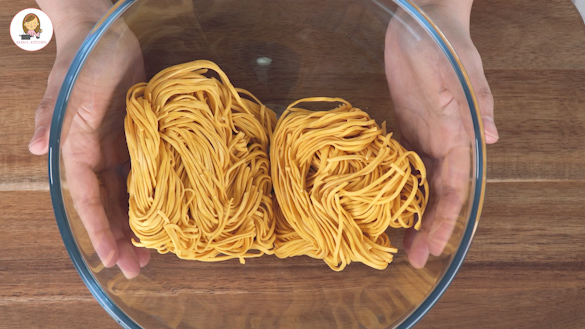
Strain noodles after 8 mins and drizzle 1 teaspoon of sesame/vegetable oil. Mix well and set aside.
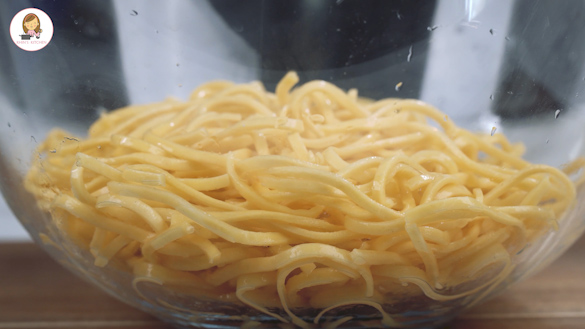
Cut chicken into small pieces. Marinate with light soy sauce, sesame oil and baking soda.
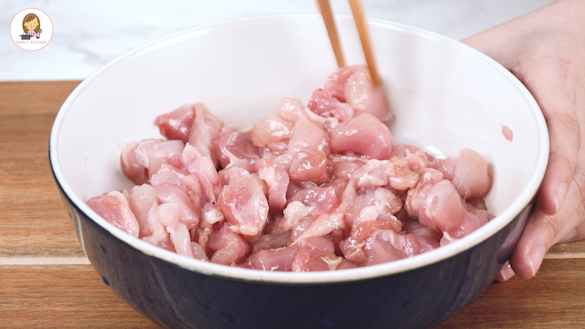
Cut vegetables into 2" thin slices. Roughly chop garlic cloves.
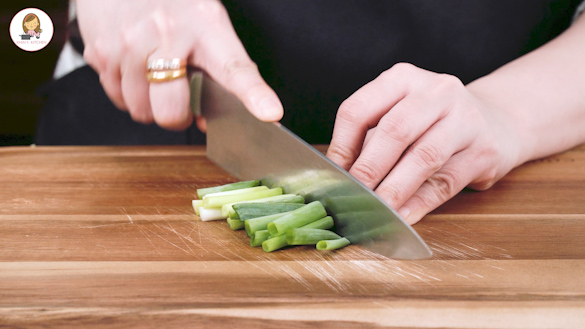
In a small bowl, mix all the stir fry sauce ingredients and set aside.
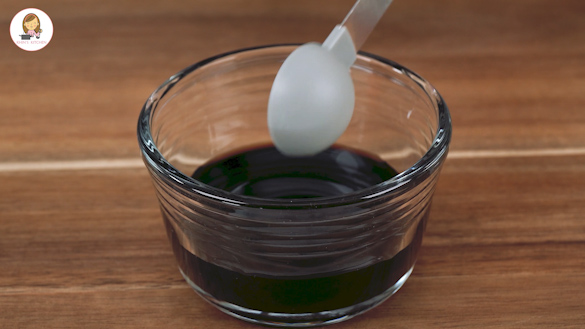
Heat the wok to medium high heat. Add ½ tbsp of vegetable oil. Stir fry the chopped garlic for few seconds. Then add chicken pieces and stir fry the chicken for 2-3 minutes until cook through.
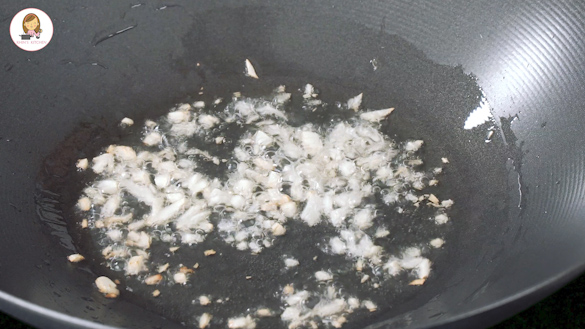
Add vegetables, start from hard ones( leave spring onion to add later ). Stir well to combine all ingredients evenly about 1 to 2 mins.
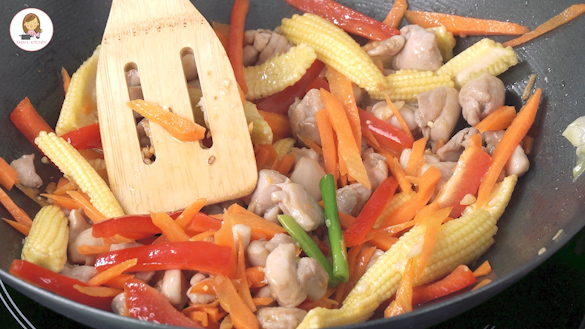
Remove from the wok and set aside.
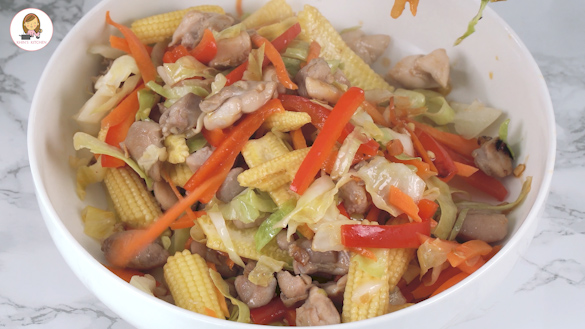
Drizzle a bit more oil to wok and stir fry the noodles for few seconds . Then pour the stir fry sauce in, stir well.
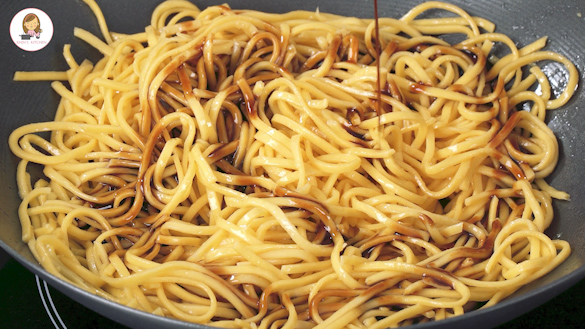
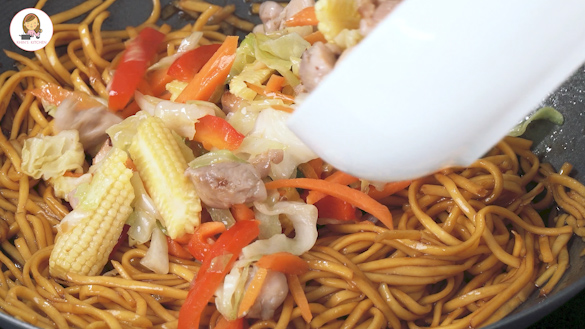
Add the stir fried chicken and vegetables back to wok. Then add the spring onions and 1 teaspoon of salt. Mix well to combine all ingredients together. Continue stir fry for 2 to 3 minutes.
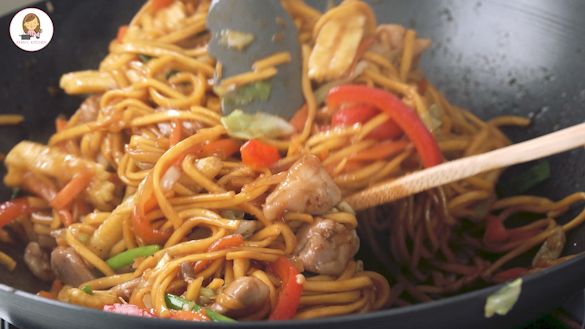
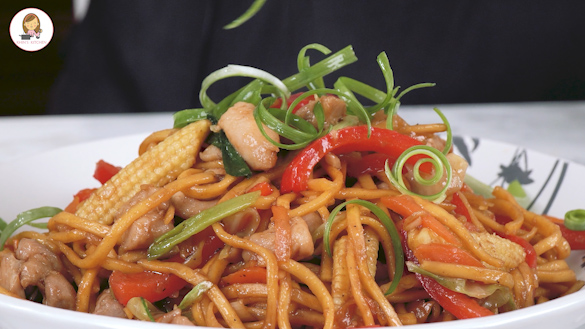
Delicious Stir Fry Noodle is ready. Serve immediately!
I have other delicious stir fry noodle recipes you can try :
If you enjoy our recipe, please leave a comment and give us a rating! If you’ve tried this recipe, tag me on social media, I would love to see your creations! Follow me on social media Facebook, Instagram and Pinterest for the latest updates.
Watch How to Make Chicken Chow Mein Recipe Video
📖 Recipe

Chicken Chow Mein ( Stir Fry Chicken Noodles )
Ingredients
Main Ingredients
- 200 g Boneless chicken thigh
- 300 g Egg noodle (fresh or boiled)
- 3 Cloves Garlic
- 1 Carrot
- 3-4 Cabbage Leaves
- 1 Bell Pepper Red/Green
- 5-6 Baby Corn
- 2-3 Spring Onion
- 2-3 tbsp Vegetable oil
- 1 tsp Salt ( optional )
Marinate for Chicken
- 1 tsp Light soy sauce
- ½ tsp Sesame oil
- ¼ tsp Baking powder
Stir Fry Sauce
- 2 tbsp Oyster sauce
- 2 tbsp Sweet soy sauce
- 1 tbsp Light soy sauce
- 1 tbsp Dark soy sauce
- ½ tbsp Vinegar
- ½ tbsp Sesame oil
Instructions
- Soak dry egg noodles in hot boiling water for 8 to 10 mins. ( Cook your noodles by the packet instructions. If you use fresh noodles you can put straight to wok.)
- Strain noodles after 8 mins and drizzle 1 teaspoon of sesame/vegetable oil. Mix well and set aside.
- Cut chicken into small pieces. Marinate with light soy sauce, sesame oil and baking powder.
- Cut vegetables into thin slices. Roughly chop garlic cloves.
- Mix all the stir fry sauce ingredients in one bowl.
- Heat the wok. Add ½ tbsp of oil. Stir fry the chopped garlic for few seconds. Then add chicken pieces and stir fry till the chicken turned nice colour.
- Add vegetables, start from hard ones( leave spring onion to add later ). Mix well about 1 to 2 mins and remove from the wok set aside.
- Drizzle a bit more oil to wok and stir fry the noodles for few seconds. Then add the stir fry sauce, mix it well.
- Add the stir fried chicken and vegetables back to wok. Then add the spring onions and 1 teaspoon of salt. ( Optional, you can omit salt according to your taste. )
- Mix well to combine all ingredients together. Continue stir fry for 2 to 3 minutes.
- Delicious Stir Fry Noodle is ready. Serve immediately!
- Enjoy!


Jon says
Didn’t have cabbage, baby corn or red pepper so I used brown onion and it worked really well. I’ll try adding beansprouts next too. Plus i’d reduce salt to 1/4 tsp to suit my taste. Sauce was lovely!
Khin says
So glad that you enjoyed our chow mein recipe, Jon. Thanks for trying out and sharing feedback.
Diana says
Absolutely delicious! Even my picky husband thought it was great! I didn’t add any salt as soy sauces already have it. Such a good flavor!
Khin says
It's absolutely fine to skip as the soy sauces contain salt content. Thanks for trying out, Diana. I am so glad that you and your husband enjoyed this recipe.
Ryan says
You’ve changed my life for the better! Every recipe I have done of yours have been superb.
Khin says
Thank you so much Ryan.
John Cumberland says
Why does the dialogue say baking soda yet the recipe says baking powder
Khin says
Hi John, instructions corrected to baking powder. Thank you so much for pointing out.
Gary says
Thank you for showing us how to make this lovely food
Michelle Cairns says
Hi ! Your recipe looks wonderful and I would like to try. Could you tell me what noodles you use ? I can’t ever seem to buy the right ones. Thank you. X
Khin says
Hi Michelle, we usually use medium-thick egg noodles for this recipe. You can find it in most supermarket Asian aisle or Chinese Asian grocery stores.
Emee Escalas says
Nice recipe and will definetely try this but im just quite confused if how much salt i need to put. On the written ingredients it says that it needs 1 tsp salt but on the instructions its 1 tbsp though.. Can you enlighten me please which is which..? And if im going to use a superior dark soy sauce will it affect the taste and add black pepper too?
Khin says
Hi Emee, salt is 1 teaspoon ( edited in the recipe card ). As soy sauces and oyster sauce already has salt intake, you can add or exclude salt according to your taste. Hope you enjoy making it!
josee jacob says
j adore vos recette
Khin says
Thank you Josee!